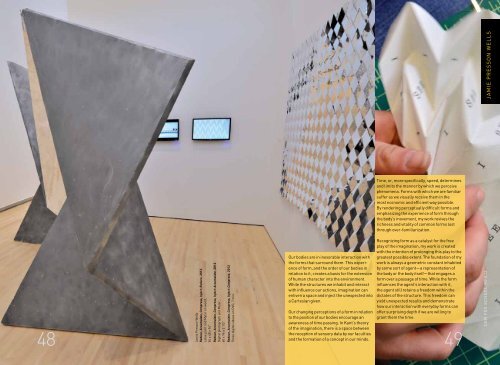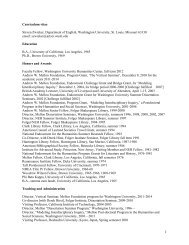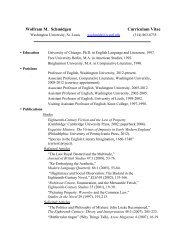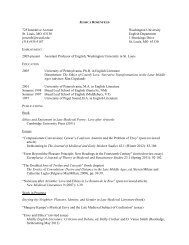samfoxschool.wustl.edu - Department of English - Washington ...
samfoxschool.wustl.edu - Department of English - Washington ...
samfoxschool.wustl.edu - Department of English - Washington ...
Create successful ePaper yourself
Turn your PDF publications into a flip-book with our unique Google optimized e-Paper software.
48 Jamie<br />
Presson Wells<br />
R<strong>edu</strong>ce, Accumulate, Compress, Inject: R<strong>edu</strong>ce, 2012<br />
Latex paint and Mylar on wood,<br />
84 x 48 x 96"<br />
R<strong>edu</strong>ce, Accumulate, Compress, Inject: Accumulate, 2012<br />
Digital photograph and Mylar,<br />
60 x 96 x 2 1/2"<br />
R<strong>edu</strong>ce, Accumulate, Compress, Inject: Compress, 2012<br />
Three digital videos on DVD, 7 min.<br />
Our bodies are in inexorable interaction with<br />
the forms that surround them. This experience<br />
<strong>of</strong> form, and the order <strong>of</strong> our bodies in<br />
relation to it, creates a basis for the extension<br />
<strong>of</strong> human character into the environment.<br />
While the structures we inhabit and interact<br />
with influence our actions, imagination can<br />
enliven a space and inject the unexpected into<br />
a Cartesian given.<br />
Our changing perceptions <strong>of</strong> a form in relation<br />
to the position <strong>of</strong> our bodies encourage an<br />
awareness <strong>of</strong> time passing. In Kant’s theory<br />
<strong>of</strong> the imagination, there is a space between<br />
the reception <strong>of</strong> sensory data by our faculties<br />
and the formation <strong>of</strong> a concept in our minds.<br />
Time, or, more specifically, speed, determines<br />
and limits the manner by which we perceive<br />
phenomena. Forms with which we are familiar<br />
suffer as we visually receive them in the<br />
most economic and efficient way possible.<br />
By rendering perceptually difficult forms and<br />
emphasizing the experience <strong>of</strong> form through<br />
the body’s movement, my work revives the<br />
richness and vitality <strong>of</strong> common forms lost<br />
through over-familiarization.<br />
Recognizing form as a catalyst for the free<br />
play <strong>of</strong> the imagination, my work is created<br />
with the intention <strong>of</strong> prolonging this play to the<br />
greatest possible extent. The foundation <strong>of</strong> my<br />
work is always a geometric constant inhabited<br />
by some sort <strong>of</strong> agent—a representation <strong>of</strong><br />
the body or the body itself—that engages a<br />
form over a passage <strong>of</strong> time. While the form<br />
influences the agent’s interaction with it,<br />
the agent still retains a freedom within the<br />
dictates <strong>of</strong> the structure. This freedom can<br />
yield unexpected results and demonstrate<br />
how our interaction with everyday forms can<br />
<strong>of</strong>fer surprising depth if we are willing to<br />
grant them the time.<br />
49<br />
STUDENT JAMIE PRESSON WELLS<br />
SAM FOX SCHOOL MFA12




![Curriculum Vitae [pdf] - Department of English](https://img.yumpu.com/40264872/1/190x245/curriculum-vitae-pdf-department-of-english.jpg?quality=85)

![Curriculum Vitae [pdf] - Department of English](https://img.yumpu.com/37932390/1/190x245/curriculum-vitae-pdf-department-of-english.jpg?quality=85)


![Curriculum Vitae [pdf] - Department of English - Washington ...](https://img.yumpu.com/7361811/1/190x245/curriculum-vitae-pdf-department-of-english-washington-.jpg?quality=85)